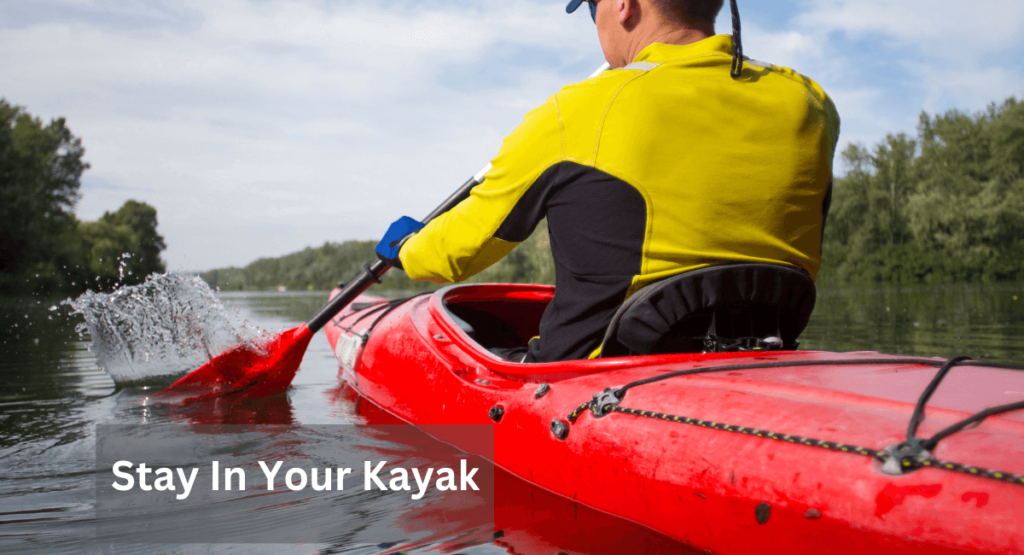If you see a shark in a kayak, remain calm and slowly paddle towards shore. Stay in your kayak and avoid splashing to not attract attention.
Seeing a shark while kayaking can be a nerve-wracking experience, but knowing how to handle the situation can make all the difference. Sharks are curious creatures, and they may approach a kayak out of curiosity. However, most sharks are not interested in attacking humans and will likely swim away once they realize there is no food source.
In the rare event of aggressive behavior, it’s important to remain composed and follow the necessary safety protocols. By being prepared and staying level-headed, you can navigate the situation safely and avoid any potential dangers. Let’s explore some essential tips for handling a shark encounter while in a kayak.
Stay Calm And Assess The Situation
Encountering a shark while kayaking can be a terrifying experience, but it’s crucial to stay calm and assess the situation. Panicking will only escalate the danger. By following a few key steps, you can minimize the risk and increase your chances of safely navigating this encounter.
Increase Awareness Of Your Surroundings
The first step is to be aware of your surroundings before and during your kayaking adventure. Understanding the area you are exploring can help you anticipate potential risks and make informed decisions. Research the location’s history of shark sightings and be mindful of any warnings or advisories from local authorities or experienced kayakers.
When you’re out on the water, keep your eyes open for signs of shark activity. Look for baitfish or birds diving into the water, as these could indicate the presence of sharks feeding below the surface. Additionally, pay attention to any unusual behavior from other marine animals or sudden changes in water movement.
Evaluate The Shark’s Behavior
Once you spot a shark near your kayak, it’s essential to assess its behavior. Not all encounters are threatening, and understanding the shark’s intentions can help you make informed decisions. Here are a few behaviors to observe:
- Aggressive or Erratic Movement: If the shark is displaying aggressive or erratic behavior, such as swimming rapidly towards your kayak or thrashing in the water, it may be best to assume it is agitated. In this case, it’s important to take immediate action to distance yourself from the shark.
- Circling or Curious Approach: Some sharks may exhibit curious behavior, circling your kayak or approaching slowly. While this can be intimidating, it doesn’t necessarily mean an imminent threat. Stay vigilant and maintain a calm demeanor.
- Passing By: If the shark swims past your kayak without showing any interest in you, it’s likely just passing through the area. Use this opportunity to calmly observe its movement before continuing your paddling.
Regardless of the shark’s behavior, avoid making sudden movements or splashing excessively, as this may provoke it. Maintain a neutral body position and avoid direct eye contact, as some species of sharks may interpret it as a threat or challenge.
Remember, each shark encounter is unique, and there is no one-size-fits-all response. Every situation demands careful observation and an individualized assessment of the circumstances. By staying calm and assessing the situation, you can make the best choices to ensure your safety during a shark encounter while kayaking.
Create Distance

If you find yourself in the presence of a shark while kayaking, it’s important to maintain your composure and take appropriate steps to ensure your safety. One of the first things you should do is to create distance between yourself and the shark. This can be accomplished through careful and deliberate actions that minimize the risk of provoking the shark, while also increasing the likelihood of safely navigating the situation.
Paddle Away Slowly
When you spot a shark near your kayak, it’s crucial to remain calm and avoid making sudden movements. Slowly and steadily paddle away from the shark, keeping your movements smooth and controlled. Avoid splashing or making erratic motions that could attract the shark’s attention. By maintaining a steady pace and gradually increasing the distance between yourself and the shark, you can reduce the likelihood of a confrontation.
Use Deterrent Devices If Available
If you have access to deterrent devices such as shark repellent, it’s advisable to use them. While kayaking, carrying a shark deterrent device can provide an added layer of protection in the event of a shark encounter. These devices emit signals or substances that can deter sharks from approaching, giving you an extra means of creating distance between yourself and the shark. Always familiarize yourself with the proper usage of deterrent devices before venturing out on the water.
Stay In Your Kayak

If you ever find yourself in the terrifying situation of coming face to face with a shark while in your kayak, it can be a heart-stopping moment. However, it’s crucial to stay calm and follow the right steps to ensure your safety. One of the most important things you can do in this scenario is to stay in your kayak. It can be tempting to panic and try to escape, but abandoning your kayak can lead to even greater danger.
Avoid Entering The Water
If you see a shark while in your kayak, the last thing you want to do is enter the water. Sharks are more likely to be curious or potentially aggressive when they sense movement in the water. By staying in your kayak, you minimize the chances of provoking a shark encounter and keep yourself safe from harm.
Maintain A Stable Position
When confronted with a shark, it’s vital to keep your kayak stable and avoid sudden movements. Sudden movements can attract the shark’s attention and may lead to an escalated situation. By maintaining a stable position, you reduce the likelihood of triggering any predatory behavior from the shark and increase your chances of staying safe.
Call For Help

If encountering a shark while kayaking, stay calm and slowly paddle towards shore. Signal for help and avoid sudden movements to deter the shark. Remember, safety is a priority in such situations.
Encountering a shark while kayaking can be a terrifying situation, but the most important thing to remember is to stay calm and take immediate action. One of the first steps you should take is to call for help. Let’s explore some effective ways to do this:
Use Communication Devices
When you spot a shark in your kayak, your instinct may be to grab your phone and dial emergency services. However, it’s essential to keep in mind that it can be challenging to operate a phone while in a state of panic. A more efficient option is to equip yourself with a waterproof two-way radio or a personal locator beacon (PLB). These devices can allow you to quickly communicate with emergency services or nearby boats.
Signal Nearby Boats Or Individuals
If you are unable to contact emergency services directly, try attracting the attention of boats or individuals nearby. There are several effective ways to achieve this:
- Use visual signals: Wave your paddle or any bright-colored object in the air to catch the attention of people in the vicinity.
- Sound signals: Blow a whistle or use an air horn to create a loud noise that can alert nearby boats or individuals.
- Flares: Flares are highly visible and can be a lifesaver in emergencies. Keep marine flares in your kayak as part of your safety gear.
- Smoke signals: In certain conditions, such as low visibility or if boats are farther away, deploying a smoke signal can help to make your presence known.
Remember, it’s crucial to remain vigilant and continuously assess the situation while waiting for help to arrive. Use these communication methods to increase your chances of getting aid quickly.
Stay Vigilant After The Encounter
Monitor Your Surroundings
Continue to keep a close eye on the water around your kayak for any signs of other sharks.
Report The Incident
Inform the local authorities or relevant wildlife organizations about the sighting of the shark to help in tracking its movements.
Frequently Asked Questions On What To Do If You See A Shark In A Kayak
What To Do If You See A Shark While Kayaking?
If you see a shark while kayaking, remain calm and slowly paddle towards shore. Avoid splashing or making sudden movements, which may attract the shark. If the shark approaches, use any available object to defend yourself and try to maintain eye contact.
Remember, shark attacks are rare.
What To Do If A Shark Is Circling You?
If a shark is circling you, stay calm and maintain eye contact. Slowly back away, avoiding sudden movements. Do not turn your back or play dead. Use any nearby object as a barrier, and if attacked, aim for the shark’s sensitive areas.
Seek medical help immediately.
Should You Leave The Water If You See A Shark?
Yes, you should leave the water if you see a shark to reduce the risk of encountering it.
What Color Kayak Attracts Sharks?
Sharks are attracted more to movement and the smell of blood than to specific kayak colors. There is no evidence that any color attracts sharks. Always keep safety in mind and avoid paddling in areas with high shark activity.
Conclusion
In case of a shark encounter, while kayaking, it is crucial to stay calm and avoid sudden movements. Remember, sharks are curious creatures and not necessarily predators. Slowly and calmly make your way towards shore, maintaining eye contact with the shark.
Once on land, report the sighting to local authorities for the safety of other beachgoers. By following these guidelines, you can minimize the risks associated with a shark encounter while kayaking and ensure a safe and memorable experience.
